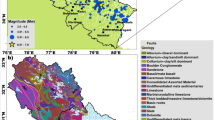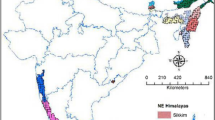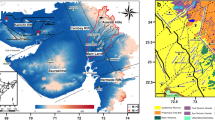Abstract
An earthquake hazard zonation map of Sikkim Himalaya is prepared using eight thematic layers namely Geology (GE), Soil Site Class (SO), Slope (SL), Landslide (LS), Rock Outcrop (RO), Frequency–Wavenumber (F–K) simulated Peak Ground Acceleration (PGA), Predominant Frequency (PF), and Site Response (SR) at predominant frequencies using Geographic Information System (GIS). This necessitates a large scale seismicity analysis for seismic source zone classification and estimation of maximum earthquake magnitude or maximum credible earthquake to be used as a scenario earthquake for a deterministic or quasi-probabilistic seismic scenario generation. The International Seismological Center (ISC) and Global Centroid Moment Tensor (GCMT) catalogues have been used in the present analysis. Combining b-value, fractal correlation dimension (Dc) of the epicenters and the underlying tectonic framework, four seismic source zones are classified in the northeast Indian region. Maximum Earthquake of M W 8.3 is estimated for the Eastern Himalayan Zone (EHZ) and is used to generate the seismic scenario of the region. The Geohazard map is obtained through the integration of the geological and geomorphological themes namely GE, SO, SL, LS, and RO following a pair-wise comparison in an Analytical Hierarchy Process (AHP). Detail analysis of SR at all the recording stations by receiver function technique is performed using 80 significant events recorded by the Sikkim Strong Motion Array (SSMA). The ground motion synthesis is performed using F–K integration and the corresponding PGA has been estimated using random vibration theory (RVT). Testing for earthquakes of magnitude greater than M W 5, a few cases presented here, establishes the efficacy and robustness of the F–K simulation algorithm. The geohazard coverage is overlaid and sequentially integrated with PGA, PF, and SR vector layers, in order to evolve the ultimate earthquake hazard microzonation coverage of the territory. Earthquake Hazard Index (EHI) quantitatively classifies the terrain into six hazard levels, while five classes could be identified following the Bureau of Indian Standards (BIS) PGA nomenclature for the seismic zonation of India. EHI is found to vary between 0.15 to 0.83 quantitatively classifying the terrain into six hazard levels as “Low” corresponding to BIS Zone II, “Moderate” corresponding to BIS Zone III, “Moderately High” belonging to BIS Zone IV, “High” corresponding to BIS Zone V(A), “Very High” and “Severe” with new BIS zones to Zone V(B) and V(C) respectively.























Similar content being viewed by others
References
Aki K (1965) Maximum likelihood estimate of b in the formula log N = a − bM and its confidence limits. Bull Earthq Res Inst 43:237–239
Bak P, Tang C (1989) Earthquakes as a self-organized critical phenomenon. J Geophys Res 94:15635–15637
Bender B (1983) Maximum likelihood estimation of b-values for magnitude grouped data. Bull Seismol Soc Am 73:831–851
Ben-Menahem A, Aboodi E, Schild R (1974) The source of the great Assam earthquake, an interplate wedge motion. Phys Earth Planet Int 9:265–289
Bilham R, Ambraseys N (2005) Apparent Himalayan slip deficit from the summation of seismic moments for Himalayan earthquakes. Curr Sci 88:1658–1663
BIS (2002) IS 1893–2002 (Part 1): Indian Standard Criteria for earthquake resistant design of structures, Part 1—General Provisions and Buildings, Bureau of Indian Standards, New Delhi
Boore DM (1983) Stochastic simulation of high frequency ground motions based on seismological models of the radiated spectra. Bull Seismol Soc Am 73:1865–1894
Borcherdt RD (1970) Effects of local geology on ground motion near San Francisco Bay. Bull Seismol Soc Am 60:29–61
Braunmiller J, Deichmann N, Giardini D, Wiemer S (2005) Homogeneous moment-magnitude calibration in Switzerland. Bull Seismol Soc Am 95:58–74
Brune J, Engen G (1969) Excitation of mantle love waves and definition of mantle wave magnitude. Bull Seismol Soc Am 57:1355–1365
Cartwright DE, Longuet-Higgins MS (1956) The statistical distribution of the maxima of a random function. Proc R Soc Lond Ser 237:212–223
Chen W, Molnar P (1977) Seismic moments of major earthquakes and average rate of slip in Central Asia. J Geophys Res 82:2945–2969
Dasgupta S, Pande P, Ganguly D, Iqbal Z et al (2000) Seismotectonic atlas of India and its environs. Geol Survey, India
Deichmann N (2006) Local magnitude, a moment revisited. Bull Seismol Soc Am 96:1267–1277
Field EH, Jacob KH (1995) A comparison and test of various site response estimation techniques, including three that are not reference site dependent. Bull Seismol Soc Am 85:1127–1143
Field EH, Jacob KH, Hough SE (1992) Earthquake site response estimation: a weak motion case study. Bull Seismol Soc Am 82:2283–2307
Gansser A (1964) Geology of the Himalayas. Interscience Publ, New York, p 289
Grassberger P, Procaccia I (1983) Measuring the strangeness of strange attractors. Physica D 9:189–208
Gutenberg GB, Richter CF (1944) Frequency of earthquakes in California. Bull Seismol Soc Am 34:185–188
Hanks TC, Kanamori H (1979) A moment magnitude scale. J Geophys Res 84:2348–2350
Haskell NA (1963) Radiation pattern of Rayleigh waves from a fault of arbitrary dip and direction of motion in a homogeneous medium. Bull Seismol Soc Am 53:619–642
Haskell NA (1964) Radiation pattern of surface waves from point sources in a multilayer medium. Bull Seismol Soc Am 54:377–393
Heaton TH, Tajima F, Mori AW (1986) Estimating ground motion using recorded accelerograms. Surv Geophys 8:25–83
Helmberger DV (1968) The crust-mantle transition in the Bering sea. Bull Seismol Soc Am 58:179–214
Herrmann RB (1979) SH wave generation by disclocation sources-a numerical studies. Bull Seismol Soc Am 69:1–15
Herrmann RB, Mandal B (1986) A study of wavenumber integration techniques. Earthq Notes 57:33–40
Hohl P (1998) GIS Data Conversion: strategies, techniques, and management. OnWord Press, Albany, New York, p 423
Hudson JA (1969) A quantitative evaluation of seismic signals at teleseismic distances—II Body waves and surface waves from and extended source. Geophys J 18:353–370
ISC (2007) On-line Bulletin, http://www.isc.ac.uk/search/index.html, International Seismological Centre, Thatcham, United Kingdom
Kagan YY (1993) Statistics of characteristics earthquakes. Bull Seismol Soc Am 83:7–24
Kagan YY (2007) Earthquake spatial distribution: the correlation dimension. Geophys J Int 168(3):1175–1194
Kagan YY, Knopoff L (1980) Spatial distribution of earthquakes: the two point correlation function. Geophys J R Astron Soc 62:303–320
Kanamori H (1977) The energy release in Great Earthquakes. J Geophy Res 82:2981–2987
Koravos GCh, Main IG, Tsapanos TM, Musson RMW (2003) Maximum earthquake magnitudes in the Aegean area constrained by tectonic moment release rates. Geophys J Int 152:94–112
Korte GB (1997) The GIS Book: understanding the value and implementation of Geographic Information Systems. OnWord Press, Albany, New York, p 440
Langston CA (1979) Structure under Mount Rainier, Washington, inferred from teleseismic body waves. J Geophys Res 84:4749–4762
Lavé J, Yule D, Sapkota S, Basant K, Madden C, Attal M, Pandey R (2005) Evidence for a Great Medieval Earthquake (∼1100 AD) in the Central Himalayas, Nepal. Science 307:1302–1305
Lermo J, Chávez-García FJ (1993) Site effect evaluation using spectral ratios with only one station. Bull Seismol Soc Am 83(5):1574–1594
Main IG (1995) Earthquakes as critical phenomena: implications for probabilistic Seismic Hazard Analysis. Bull Seismol Soc Am 85:1299–1308
Main IG, Irving D, Musson R, Reading A (1999) Constraints on the frequency-magnitude relation and maximum magnitudes in the UK from observed seismicity and glacio-isostatic recovery rates. Geophys J Int 137:535–550
Marble DF, Pequet DJ (1983) Geographic information system and remote sensing, in Manual of Remote Sensing. American Society of Photogrammetry, Falls Church, VA
McHarg I (1969) Design with nature. National History Press, New York
Nakamura Y (1989) A method for dynamic characteristics estimations of subsurface using microtremors on the ground surface. Q Rep Rail Tech Res Inst 30:25–33
Narenberg MAA, Essex C (1990) Correlation dimension and systematic geometric effects. Phys Rev A 42:7065–7074
Nath SK, Sengupta P, Sengupta S, Chakrabarti A (2000) Site response estimation using Strong Motion network: a step towards microzonation of Sikkim Himalayas, Seismology 2000. Curr Sci 79:1316–1326
Nath SK, Biswas NN, Dravinski M, Papageorgiou A (2002a) Determination of S-wave site response in Anchorage, Alaska in the 1–9 Hz frequency band. Pure Appl Geophys 159:2673–2698
Nath SK, Sengupta P, Kayal JR (2002b) Determination of site response at Garhwal Himalaya from the aftershock sequence of 1999 Chamoli Earthquake. Bull Seismol Soc Am 92:1071–1081
Nath SK, Vyas M, Pal I, Sengupta P (2005) A Hazard Scenario in the Sikkim Himalaya from seismotectonics, spectral amplification, source parameterization and spectral attenuation laws using Strong Motion Seismometry. J Geophys Res 110:B01301, doi:10.1029/2004JB003199
National Bureau of Soil Survey (1994) Master Plan for Irrigation Development, Sikkim, Govt. of Sikkim, Agricultural Finance Corporation Ltd, Report 2:35–47
Ristau J, Rogers GC, Cassidy JF (2005) Moment magnitude–local magnitude calibration for earthquakes in Western Canada. Bull Seismol Soc Am 95:1994–2000
Rong Y (2002) Evaluation of earthquake potential in China. PhD Dissertation, Geophysics and Space Physics, University of California, Los Angeles
Saaty TL (1980) The analytic hierarchy process. McGraw-Hill International, New York, NY, USA
Saaty TL (1990) An exposition of the AHP in reply to the paper remarks on the analytic hierarchy process. Manage Sci 36:259–268
Scordilis EM (2006) Empirical global relations converting M S and m b to moment magnitude. J Seismol 10:225–236
Seekins LC, Wennerberg L, Margheriti L, Liu HP (1996) Site amplification at five locations in San Francisco, California; a comparison of S-waves, codas, and microtremors. Bull Seismol Soc Am 86:627–635
Utsu T (1965) A method for determining the value of b in the formula log N = a – bM showing the magnitude–frequency relation for the earthquakes. Geophys Bull Hokkaido Univ 13:99–103
Utsu T (1999) Representation and analysis of the earthquake size distribution: a historical review and some new approaches. Pure Appl Geophys 155:509–535
Vanmarcke EH, Lai SP (1980) Strong motion duration of earthquakes. Bull Seismol Soc Am 70:1293–1307
Wang CY, Herrmann RB (1980) A numerical study of P-, SV-, and SH-wave generation in a plane layered medium. Bull Seismol Soc Am 70:1015–1036
Wiemer S, Wyss M (2000) Minimum magnitude of completeness in earthquake catalogs: examples from Alaska, the western US and Japan. Bull Seismol Soc Am 90:859–869
Acknowledgements
The Department of Science and Technology, Seismology Division, Government of India supported this investigation vide sanction number DST/23(97)/ESS/95, DST/23(218)/ESS/98 and DST/23(574)/SU/2005. The continuous support received from the State Council of Science and Technology, Government of Sikkim in maintaining the Sikkim Strong Motion Array of IIT Kharagpur is gratefully acknowledged. The critical and in-depth review of the manuscript and the constructive suggestions by Christos A. Papaioannou, the anonymous referee and the advisor greatly helped in improving the manuscript with enhanced scientific clarity and exposition.
Author information
Authors and Affiliations
Corresponding author
Rights and permissions
About this article
Cite this article
Pal, I., Nath, S.K., Shukla, K. et al. Earthquake hazard zonation of Sikkim Himalaya using a GIS platform. Nat Hazards 45, 333–377 (2008). https://doi.org/10.1007/s11069-007-9173-7
Received:
Accepted:
Published:
Issue Date:
DOI: https://doi.org/10.1007/s11069-007-9173-7




